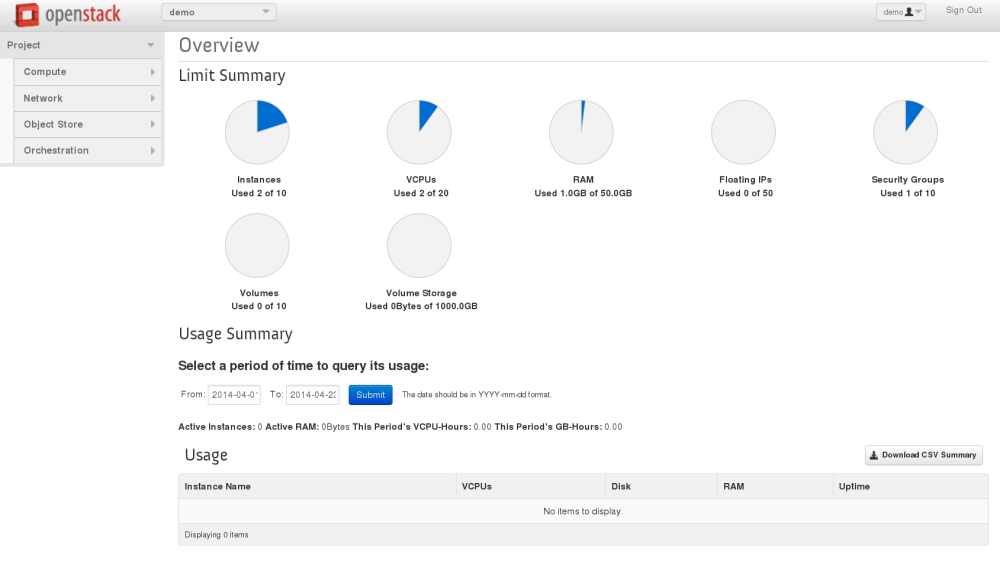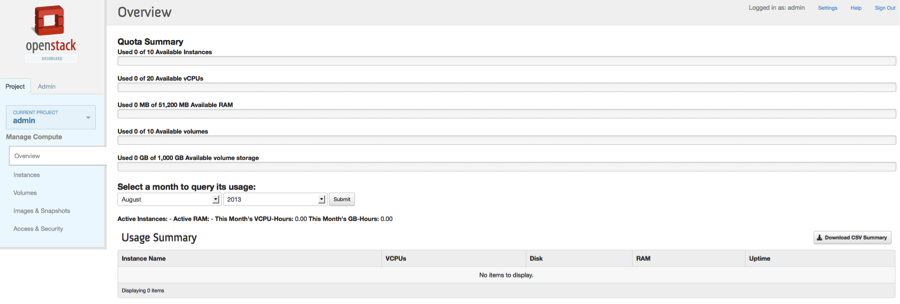OpenStack dashboard¶
As a cloud end user, you can use the OpenStack dashboard to provision your own resources within the limits set by administrators. You can modify the examples provided in this section to create other types and sizes of server instances.
Log in to the dashboard¶
The dashboard is available on the node with the nova-dashboard
server role.
Ask the cloud operator for the host name or public IP address from which you can access the dashboard, and for your user name and password.
Open a web browser that has JavaScript and cookies enabled.
Note
To use the Virtual Network Computing (VNC) client for the dashboard, your browser must support HTML5 Canvas and HTML5 WebSockets. The VNC client is based on noVNC. For details, see noVNC: HTML5 VNC Client. For a list of supported browsers, see Browser support.
In the address bar, enter the host name or IP address for the dashboard.
https://ipAddressOrHostName/
Note
If a certificate warning appears when you try to access the URL for the first time, a self-signed certificate is in use, which is not considered trustworthy by default. Verify the certificate or add an exception in the browser to bypass the warning.
On the Log In page, enter your user name and password, and click Sign In.
The top of the window displays your user name. You can also access Settings or sign out of the dashboard.
The visible tabs and functions in the dashboard depend on the access permissions, or roles, of the user you are logged in as.
- If you are logged in as an end user, the Project tab is displayed.
- If you are logged in as an administrator, the Project tab (OpenStack dashboard—Project tab) and Admin tab (OpenStack dashboard—Admin tab) are displayed.
OpenStack dashboard—Project tab¶
Projects are organizational units in the cloud, and are also known as tenants or accounts. Each user is a member of one or more projects. Within a project, a user creates and manages instances.
From the Project tab, you can view and manage the resources in a selected project, including instances and images. You select the project from the CURRENT PROJECT list at the top of the tab.
Figure: Project tab

Project tab¶
From the Project tab, you can access the following tabs:
Compute tab¶
Overview: View reports for the project.
Instances: View, launch, create a snapshot from, stop, pause, or reboot instances, or connect to them through VNC.
Volumes: Use the following tabs to complete these tasks:
- Volumes: View, create, edit, and delete volumes.
- Volume Snapshots: View, create, edit, and delete volume snapshots.
- Images: View images and instance snapshots created by project users, plus any images that are publicly available. Create, edit, and delete images, and launch instances from images and snapshots.
Access & Security: Use the following tabs to complete these tasks:
- Security Groups: View, create, edit, and delete security groups and security group rules.
- Key Pairs: View, create, edit, import, and delete key pairs.
- Floating IPs: Allocate an IP address to or release it from a project.
- API Access: View API endpoints.
Network tab¶
Network Topology: View the network topology.
Networks: Create and manage public and private networks.
Routers: Create and manage subnets.
Object Store tab¶
Containers: Create and manage containers and objects.
Orchestration tab¶
- Stacks: Use the REST API to orchestrate multiple composite cloud
- applications.
OpenStack dashboard—Admin tab¶
Administrative users can use the Admin tab to view usage and to manage instances, volumes, flavors, images, projects, users, services, and quotas.
Figure: Admin tab

Admin tab¶
Access the following categories to complete these tasks:
System Panel tab¶
Overview: View basic reports.
Resource Usage: Use the following tabs to view the following usages:
Daily Report: View the daily report.
Stats: View the statistics of all resources.
Hypervisors: View the hypervisor summary.
Host Aggregates: View, create, and edit host aggregates. View the list of availability zones.
Instances: View, pause, resume, suspend, migrate, soft or hard reboot, and delete running instances that belong to users of some, but not all, projects. Also, view the log for an instance or access an instance through VNC.
Volumes: View, create, edit, and delete volumes and volume types.
Flavors: View, create, edit, view extra specifications for, and delete flavors. A flavor is size of an instance.
Images: View, create, edit properties for, and delete custom images.
Networks: View, create, edit properties for, and delete networks.
Routers: View, create, edit properties for, and delete routers.
System Info: Use the following tabs to view the service information:
- Services: View a list of the services.
- Compute Services: View a list of all Compute services.
Network Agents: View the network agents.
Default Quotas: View default quota values. Quotas are hard-coded in OpenStack Compute and define the maximum allowable size and number of resources.
Identity Panel tab¶
Projects: View, create, assign users to, remove users from, and delete projects.
Users: View, create, enable, disable, and delete users.

Except where otherwise noted, this document is licensed under Creative Commons Attribution 3.0 License. See all OpenStack Legal Documents.